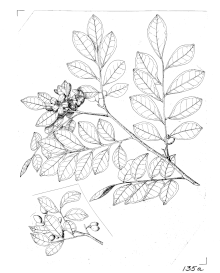Murraya paniculata
| Murraya paniculata | |
|---|---|
 |
|
| Line drawing of Murraya paniculata, showing flowers and fruit | |
| Scientific classification | |
| Kingdom: | Plantae |
| (unranked): | Angiosperms |
| (unranked): | Eudicots |
| (unranked): | Rosids |
| Order: | Sapindales |
| Family: | Rutaceae |
| Genus: | Murraya |
| Species: | M. paniculata |
| Binomial name | |
|
Murraya paniculata (L.) Jack |
|
| Synonyms | |
|
|
Murraya paniculata is a tropical, evergreen plant native to southern China, Taiwan, the Indian sub-continent (i.e. Bangladesh, India, Nepal, north-eastern Pakistan and Sri Lanka), south-eastern Asia (i.e. Cambodia, Laos, Myanmar, Thailand, Vietnam, Indonesia, Malaysia and the Philippines and northern Australia (i.e. the northern parts of the Northern Territory, far northern Queensland and northern Western Australia), bearing small, white, scented flowers, which is grown as an ornamental tree or hedge. Murraya is closely related to Citrus, and bears small orange to red fruit resembling kumquats, though some cultivars do not set fruit.
Pretty to look at but Murraya Paniculata (exotica) is recorded as an invasive weed by many Australian councils. It is spread by birds, self-propagates and the roots are also invasive in seach of moisture. It invades natural habitats and is highly ranked on Australia's most invasive weed list. This weed was introduced to areas in Australia and marketed as a easy to grow hedge which, when in flower, is highly allergenic to many of the population. Sufferers experience headache, blocked sinuses and breathing difficulties, etc. It may be in the citrus family but there's nothing healthy about a fully flowering Murraya hedge on a hot summer's night.[1]
...
Wikipedia
